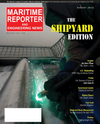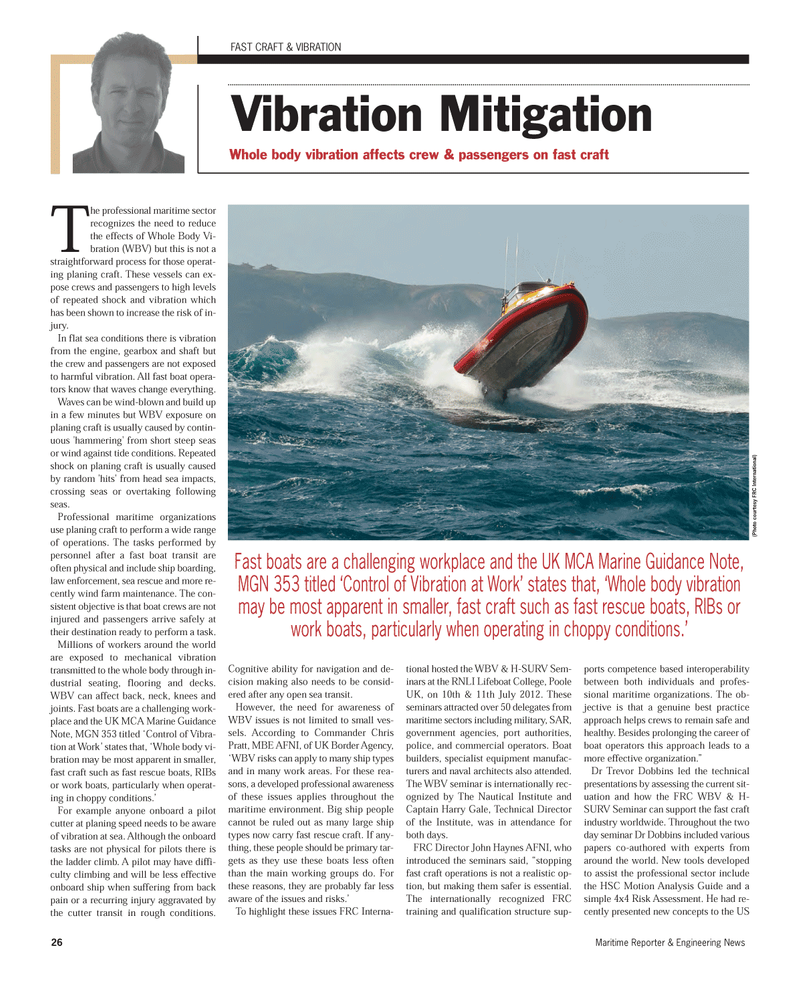
Page 26: of Maritime Reporter Magazine (August 2012)
The Shipyard Edition
Read this page in Pdf, Flash or Html5 edition of August 2012 Maritime Reporter Magazine
26Maritime Reporter & Engineering News The professional maritime sectorrecognizes the need to reducethe effects of Whole Body Vi- bration (WBV) but this is not a straightforward process for those operat- ing planing craft. These vessels can ex- pose crews and passengers to high levels of repeated shock and vibration whichhas been shown to increase the risk of in- jury. In flat sea conditions there is vibrationfrom the engine, gearbox and shaft but the crew and passengers are not exposed to harmful vibration. All fast boat opera- tors know that waves change everything. Waves can be wind-blown and build up in a few minutes but WBV exposure on planing craft is usually caused by contin-uous 'hammering' from short steep seasor wind against tide conditions. Repeated shock on planing craft is usually causedby random 'hits' from head sea impacts,crossing seas or overtaking following seas.Professional maritime organizations use planing craft to perform a wide rangeof operations. The tasks performed by personnel after a fast boat transit are often physical and include ship boarding, law enforcement, sea rescue and more re- cently wind farm maintenance. The con- sistent objective is that boat crews are not injured and passengers arrive safely at their destination ready to perform a task. Millions of workers around the world are exposed to mechanical vibration transmitted to the whole body through in-dustrial seating, flooring and decks.WBV can affect back, neck, knees and joints. Fast boats are a challenging work- place and the UK MCA Marine GuidanceNote, MGN 353 titled ?Control of Vibra- tion at Work? states that, ?Whole body vi- bration may be most apparent in smaller, fast craft such as fast rescue boats, RIBs or work boats, particularly when operat- ing in choppy conditions.? For example anyone onboard a pilot cutter at planing speed needs to be aware of vibration at sea. Although the onboard tasks are not physical for pilots there is the ladder climb. A pilot may have diffi- culty climbing and will be less effective onboard ship when suffering from back pain or a recurring injury aggravated by the cutter transit in rough conditions.Cognitive ability for navigation and de- cision making also needs to be consid-ered after any open sea transit. However, the need for awareness of WBV issues is not limited to small ves- sels. According to Commander Chris Pratt, MBE AFNI, of UK Border Agency, ?WBV risks can apply to many ship types and in many work areas. For these rea- sons, a developed professional awareness of these issues applies throughout themaritime environment. Big ship people cannot be ruled out as many large ship types now carry fast rescue craft. If any- thing, these people should be primary tar- gets as they use these boats less often than the main working groups do. For these reasons, they are probably far less aware of the issues and risks.? To highlight these issues FRC Interna- tional hosted the WBV & H-SURV Sem- inars at the RNLI Lifeboat College, Poole UK, on 10th & 11th July 2012. These seminars attracted over 50 delegates from maritime sectors including military, SAR, government agencies, port authorities, police, and commercial operators. Boatbuilders, specialist equipment manufac- turers and naval architects also attended. The WBV seminar is internationally rec- ognized by The Nautical Institute and Captain Harry Gale, Technical Director of the Institute, was in attendance for both days.FRC Director John Haynes AFNI, who introduced the seminars said, ?stoppingfast craft operations is not a realistic op- tion, but making them safer is essential. The internationally recognized FRCtraining and qualification structure sup- ports competence based interoperabilitybetween both individuals and profes- sional maritime organizations. The ob- jective is that a genuine best practice approach helps crews to remain safe and healthy. Besides prolonging the career of boat operators this approach leads to amore effective organization.? Dr Trevor Dobbins led the technical presentations by assessing the current sit-uation and how the FRC WBV & H- SURV Seminar can support the fast craft industry worldwide. Throughout the two day seminar Dr Dobbins included various papers co-authored with experts from around the world. New tools developed to assist the professional sector includethe HSC Motion Analysis Guide and a simple 4x4 Risk Assessment. He had re- cently presented new concepts to the US FAST CRAFT & VIBRATION Vibration Mitigation Whole body vibration affects crew & passengers on fast craft (Photo courtesy FRC International) Fast boats are a challenging workplace and the UK MCA Marine Guidance Note, MGN 353 titled ?Control of Vibration at Work? states that, ?Whole body vibration may be most apparent in smaller, fast craft such as fast rescue boats, RIBs or work boats, particularly when operating in choppy conditions.? MR#8 (26-33):MR Template 8/8/2012 11:54 AM Page 26

 25
25

 27
27
